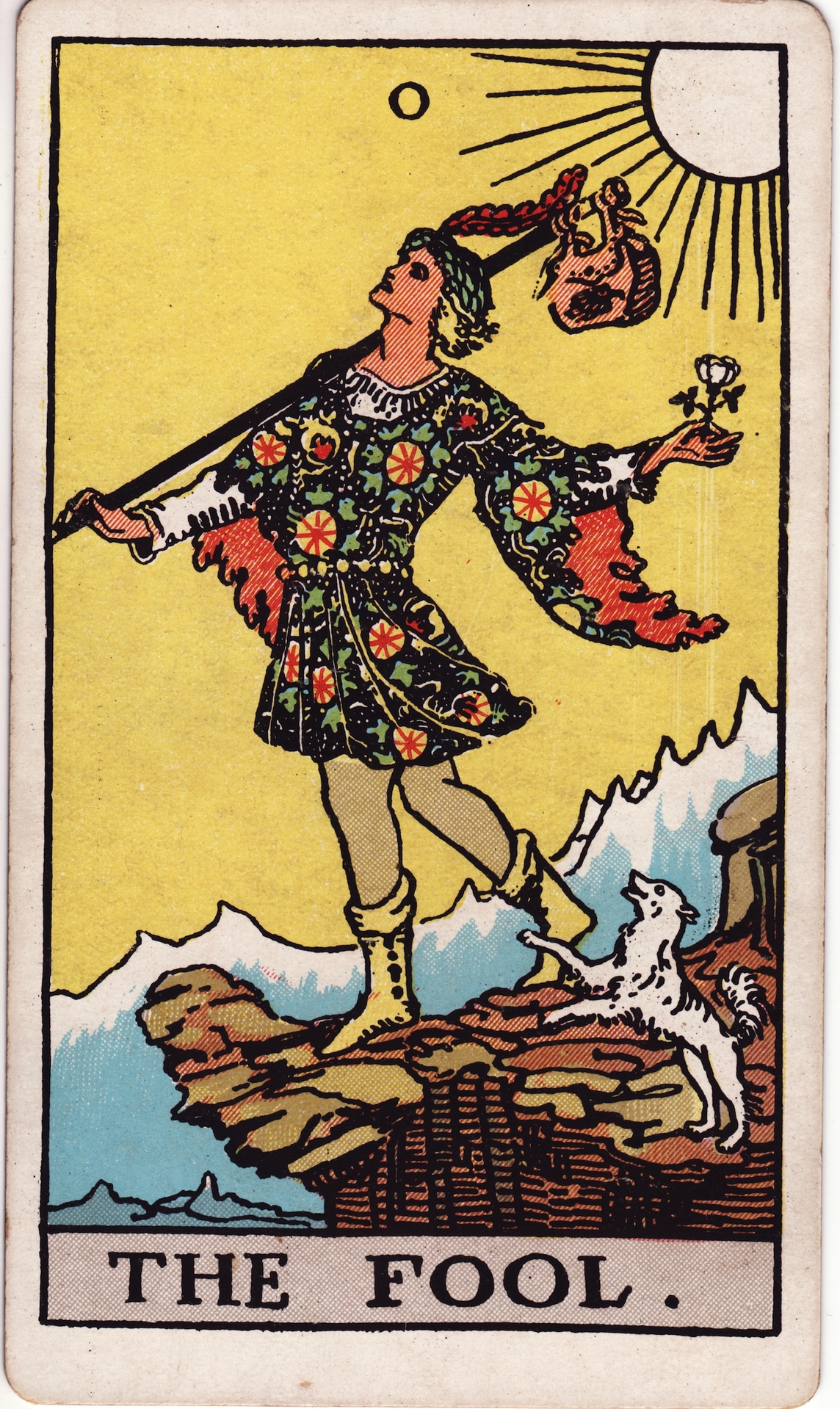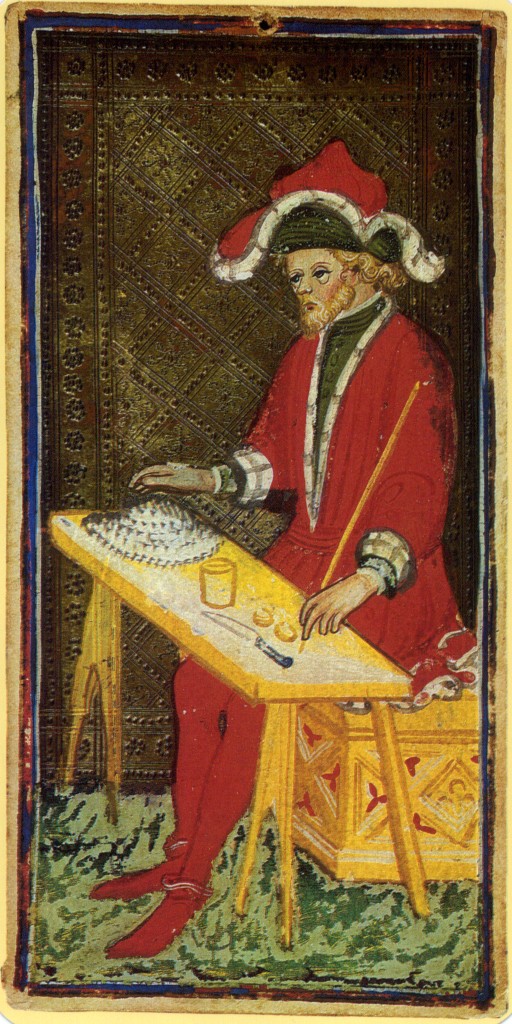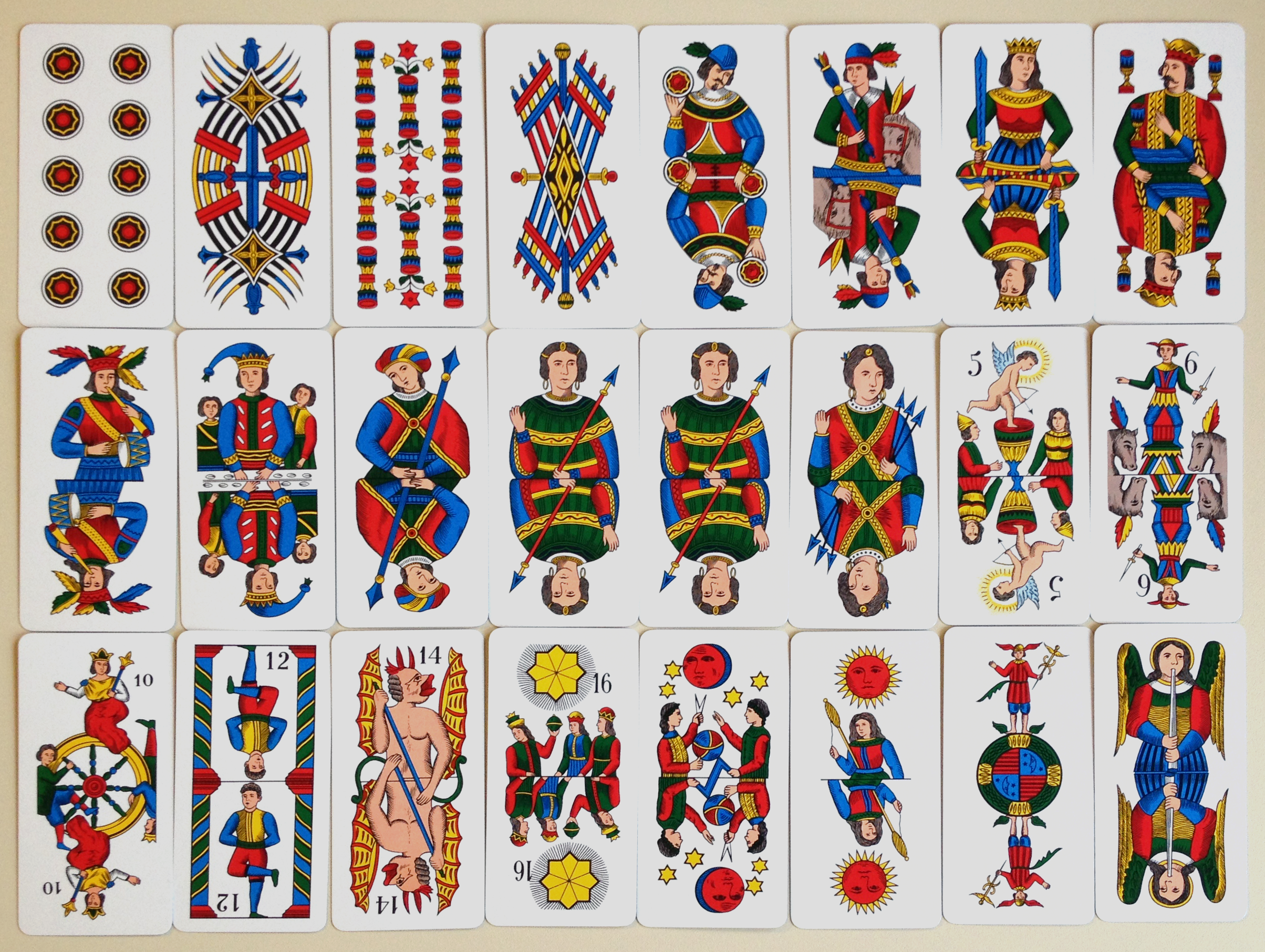|
Minchiate
Minchiate is an early 16th-century card game, originating in Florence, Italy. It is no longer widely played. ''Minchiate'' can also refer to the special deck of 97 playing cards used in the game. The deck is closely related to the tarot cards, but contains an expanded suit of trump (card games), trumps. The game was similar to but more complex than tarocchi. The minchiate represents a Florentine variant on the original game. History Florence is one of the contenders for the birthplace of tarot. The earliest reference to tarot cards, then known as Trionfi (cards), trionfi, is dated to 1440 when a notary in Florence recorded the transfer of two decks to Sigismondo Pandolfo Malatesta. The word ''minchiate'' comes from a dialect word meaning "nonsense" or "trifle", derived from ''mencla,'' the vulgar form of ''mentula'', a Latin word for "phallus". The word ''minchione'' is attested in Italian language, Italian as meaning "fool", and ''minchionare'' means "to laugh at" someone. The ... [...More Info...] [...Related Items...] OR: [Wikipedia] [Google] [Baidu] [Amazon] |
The Fool (Tarot Card)
The Fool is one of the 78 cards in a tarot deck. Traditionally, it is the lowest of the 22 trump cards, in tarot card reading called the 22 Major Arcana. However, in tarot card games it developed to be not one of the (then 21) trump cards but a special card, serving a unique purpose by itself. In later Central European tarot card games, it re-developed to now become the ''highest'' trump. As a consequence and with respect to his unique history, The Fool is usually an unnumbered card with a unique design; but sometimes it is numbered as 0 (the first) or more rarely XXII (the last). Design and numbering-or-not clearly indicate its role as a trump or special card in the specific game. Iconography The Fool is titled ''Le Mat'' in the Tarot of Marseilles, and ''Il Matto'' in most Italian language tarot decks. These archaic words mean "the madman" or "the beggar". In the earliest tarot decks, the Fool is usually depicted as a beggar or a vagabond. In the Visconti-Sforza tarot d ... [...More Info...] [...Related Items...] OR: [Wikipedia] [Google] [Baidu] [Amazon] |
Tarocchini
Tarocchini (plural for ''tarocchino'') are point trick-taking tarot card games popular in Bologna, capital city of the Emilia-Romagna region of Italy and has been confined mostly to this area. They are the diminutive form of ''tarocchi'' (plural for ''tarocco''), referring to the reduction of the Bolognese pack from 78 to 62 cards, which probably occurred in the early 16th century. The games of Tarocchini are very complex, yet the rules have changed little over the years. Deck description Tarocchini can be played with a 78-card Tarot deck (where the 2–5 pip cards in each suit have been removed), though normally, a special Tarot deck, the Tarocco Bolognese is used. The trump cards have a unique ordering where the second to fifth trumps are known collectively as the ''Moretti'' (Moors) and are of equal rank (the last one played is the highest, in regards to taking a trick). In the Tarocco Bolognese, these cards are depicted with four Moors, two of which are identical. ... [...More Info...] [...Related Items...] OR: [Wikipedia] [Google] [Baidu] [Amazon] |
Tarot
Tarot (, first known as ''trionfi (cards), trionfi'' and later as ''tarocchi'' or ''tarocks'') is a set of playing cards used in tarot games and in fortune-telling or divination. From at least the mid-15th century, the tarot was used to play trick-taking Tarot card games, card games such as Tarocchini. From their Italy, Italian roots, tarot games spread to most of Europe, evolving into new forms including German Grosstarok and modern examples such as French Tarot and Austrian Königrufen. Tarot is most commonly found in many countries, especially in English and Spanish speaking countries where tarot games are not as widely played, in the form of specially designed Cartomancy, cartomantic decks used primarily for tarot card reading, in which each card corresponds to an assigned archetype or interpretation for divination, fortune-telling or for other non-gaming uses. The emergence of custom decks for use in divination via tarot card reading and cartomancy began after Frenc ... [...More Info...] [...Related Items...] OR: [Wikipedia] [Google] [Baidu] [Amazon] |
Tarocchini
Tarocchini (plural for ''tarocchino'') are point trick-taking tarot card games popular in Bologna, capital city of the Emilia-Romagna region of Italy and has been confined mostly to this area. They are the diminutive form of ''tarocchi'' (plural for ''tarocco''), referring to the reduction of the Bolognese pack from 78 to 62 cards, which probably occurred in the early 16th century. The games of Tarocchini are very complex, yet the rules have changed little over the years. Deck description Tarocchini can be played with a 78-card Tarot deck (where the 2–5 pip cards in each suit have been removed), though normally, a special Tarot deck, the Tarocco Bolognese is used. The trump cards have a unique ordering where the second to fifth trumps are known collectively as the ''Moretti'' (Moors) and are of equal rank (the last one played is the highest, in regards to taking a trick). In the Tarocco Bolognese, these cards are depicted with four Moors, two of which are identical. ... [...More Info...] [...Related Items...] OR: [Wikipedia] [Google] [Baidu] [Amazon] |
Pratesi, Franco
Franco Pratesi (born 1940) is a retired professor of materials science and games researcher from Florence, Italy. He has contributed to the history of chess, draughts, playing cards (including Tarot games, Gemini-Minchiate) and Go. Pratesi spent years studying the archives in Florence and other towns to uncover the earliest references to playing cards. He is a Honorary Fellow of the International Playing Card Society and has written extensively in ''The Playing-Card''. Professional activity Franco Pratesi was born in 1940 in Florence and graduated in 1964 in Physical chemistry. As associate professor in the University of Florence, Pratesi was involved for decades in research and teaching of Materials Science. After early studies in molecular spectroscopy, he continued research on the structure and reactivity of single-crystal metal surfaces, and then on the high-temperature strength of superalloys. Professional Works (selection) * F. Pratesi, R. Freymann. Spectres IR de vibra ... [...More Info...] [...Related Items...] OR: [Wikipedia] [Google] [Baidu] [Amazon] |
Trionfi (cards)
Trionfi (, 'wikt:trionfi, triumphs') are 15th-century Italian playing card trumps with allegorical content related to those used in Tarot card games, tarocchi games. The general English expression "Trump (card games)#Metaphorical uses, trump card" and the German "trumpfen" (in card games) have developed from the Italian "Trionfi". Most cards feature the personification of a place or abstraction. History Many of the motifs found in trionfi are found in trionfo, theatrical processions that were popular in the Italian Renaissance. The Palazzo Schifanoia in Ferrara, once owned by the Duchy of Ferrara, ducal House of Este, contains many murals depicting these Float (parade), floats. Petrarch wrote a poem called ''I Trionfi'' which may have served as inspiration. The earliest known use of the name "Trionfi" in relation to cards can be dated to 16 September 1440 in the records of a Republic of Florence, Florentine notary, Giusto Giusti. He recorded a transaction where he transferred t ... [...More Info...] [...Related Items...] OR: [Wikipedia] [Google] [Baidu] [Amazon] |
Tarocchi
Tarot games are card games played with tarot packs designed for card play and which have a permanent trump suit alongside the usual four card suits. The games and packs which English-speakers call by the French name tarot are called tarocchi in the original Italian, Tarock in German and similar words in other languages. Tarot cards were invented in northern Italy around 1420 for the purpose of playing cards. With their appearance came the first of the two great innovations in trick-taking games since they arrived in Europe: the concept of trumps. At around the same time or slightly earlier, a similar concept arose in the game of Karnöffel. In this south German game played with an ordinary pack, some cards of the given suit had full trump powers, others were partial trumps and the 7s had a special role. These features are retained in games of the Karnöffel family to the present, but are never seen in tarot games. Suits with these variable powers are called chosen or select ... [...More Info...] [...Related Items...] OR: [Wikipedia] [Google] [Baidu] [Amazon] |
Card Game
A card game is any game that uses playing cards as the primary device with which the game is played, whether the cards are of a traditional design or specifically created for the game (proprietary). Countless card games exist, including families of related games (such as poker). A small number of card games played with traditional decks have formally standardized rules with international tournaments being held, but most are folk games whose rules may vary by region, culture, location or from circle (cards), circle to circle. Traditional card games are played with a ''deck'' or ''pack'' of playing cards which are identical in size and shape. Each card has two sides, the ''face'' and the ''back''. Normally the backs of the cards are indistinguishable. The faces of the cards may all be unique, or there can be duplicates. The composition of a deck is known to each player. In some cases several decks are Shuffling, shuffled together to form a single ''pack'' or ''shoe''. Modern car ... [...More Info...] [...Related Items...] OR: [Wikipedia] [Google] [Baidu] [Amazon] |
Liguria
Liguria (; ; , ) is a Regions of Italy, region of north-western Italy; its Capital city, capital is Genoa. Its territory is crossed by the Alps and the Apennine Mountains, Apennines Mountain chain, mountain range and is roughly coextensive with the former territory of the Republic of Genoa. Liguria is bordered by France (Provence-Alpes-Côte d'Azur) to the west, Piedmont to the north, and Emilia-Romagna and Tuscany to the east. It rests on the Ligurian Sea, and has a population of 1,509,908 as of 2025. The region is part of the Alps–Mediterranean Euroregion. Etymology The name ''Liguria'' predates Latin and is of obscure origin. The Latin adjectives (as in ) and ''Liguscus'' reveal the original root of the name, ''ligusc-'': in the Latin name -sc- was shortened to -s-, and later turned into the -r- of , according to rhotacism (sound change), rhotacism. Compare whence . The name derives from the ancient Ligures people, although the territory of this people was much larger th ... [...More Info...] [...Related Items...] OR: [Wikipedia] [Google] [Baidu] [Amazon] |
Sicily
Sicily (Italian language, Italian and ), officially the Sicilian Region (), is an island in the central Mediterranean Sea, south of the Italian Peninsula in continental Europe and is one of the 20 regions of Italy, regions of Italy. With 4.7 million inhabitants, including 1.2 million in and around the capital city of Palermo, it is both the largest and most populous island in the Mediterranean Sea. Sicily is named after the Sicels, who inhabited the eastern part of the island during the Iron Age. Sicily has a rich and unique culture in #Art and architecture, arts, Music of Sicily, music, #Literature, literature, Sicilian cuisine, cuisine, and Sicilian Baroque, architecture. Its most prominent landmark is Mount Etna, the tallest active volcano in Europe, and one of the most active in the world, currently high. The island has a typical Mediterranean climate. It is separated from Calabria by the Strait of Messina. It is one of the five Regions of Italy#Autonomous regions with s ... [...More Info...] [...Related Items...] OR: [Wikipedia] [Google] [Baidu] [Amazon] |
Grand Duchy Of Tuscany
The Grand Duchy of Tuscany (; ) was an Italian monarchy located in Central Italy that existed, with interruptions, from 1569 to 1860, replacing the Republic of Florence. The grand duchy's capital was Florence. In the 19th century the population of the Grand Duchy was about 1,815,000 inhabitants. Having brought nearly all Tuscany under his control after conquering the Republic of Siena, Cosimo I de' Medici, Grand Duke of Tuscany, Cosimo I de' Medici, was elevated by a papal bull of Pope Pius V to Grand Duke of Tuscany on 27 August 1569. The Grand Duchy was ruled by the House of Medici until the extinction of its senior branch in 1737. While not as internationally renowned as the old republic, the grand duchy thrived under the Medici and it bore witness to unprecedented economic and military success under Cosimo I and his sons, until the reign of Ferdinando II de' Medici, Grand Duke of Tuscany, Ferdinando II, which saw the beginning of the state's long economic decline. That econo ... [...More Info...] [...Related Items...] OR: [Wikipedia] [Google] [Baidu] [Amazon] |






